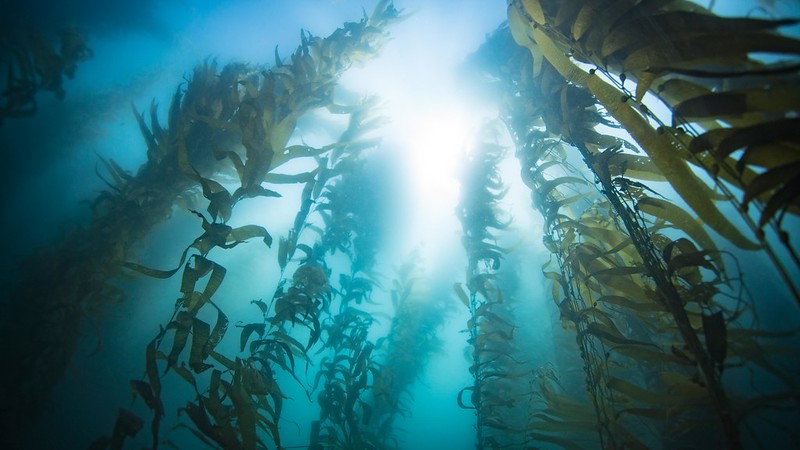Source: McPherson, Meredith L., Dennis J. I. Finger, Henry F. Houskeeper, Tom W. Bell, Mark H. Carr, Laura Rogers-Bennett, and Raphael M. Kudela. “Large-scale Shift in the Structure of a Kelp Forest Ecosystem Co-occurs with an Epizootic and Marine Heatwave.” Communications Biology 4, no. 298 (2021). https://doi.org/10.1038/s42003-021-01827-6.
The kelp forest exhibit at the Monterey Bay Aquarium displays a stunning underwater jungle. Beyond a tall glass window, giant kelp sways with the undulating motion of waves, and sunlight dapples the colorful creatures that silently swim amongst the greenish-brown blades.

Wild kelp forests thrive in Monterey Bay, but two hundred miles north of Monterey, off the coast of Sonoma and Mendocino counties, the ecosystem collapsed in 2014. The shallow waters rapidly transformed from a lush, vibrant forest into a desolate swath of urchin barrens, an ecosystem marked by masses of sea urchins and little else. Kelp die-off is normal in small patches, but the drastic decline in kelp forests that year occurred along hundreds of miles of continuous coastline. Scientists scrambled to find the cause of such an abrupt shift. Now, researchers at the University of California, Santa Cruz say an ocean warming event, a mysterious sea star disease, and other ecological factors combined to decimate the kelp forests in northern California.
Triple Threat: Warming, Disease, and an Annual Reproductive Cycle

Using satellite imagery, the scientists examined kelp density off the coast of northern California. Kelp canopies float on the surface of the water and reflect light in the near-infrared region; by measuring the kelp’s unique spectral reflectance, UCSC scientists determined the density of bull kelp in the study region from 1985 to 2019. The team noted a steep reduction in canopy coverage beginning in 2014, which coincided with an unusual marine heatwave. Simultaneously, El Niño, which prevents deep, cold waters from circulating in the ocean, descended upon the Pacific, leading to further warming. Known as “the blob” to climate scientists, this warming event continued until last year when ocean temperatures began to cool.
Kelp forests rely on the upwelling of cold, nutrient-rich seawater to maintain the ecosystem’s species richness and complexity. The persistence of warm, nutrient-poor waters after 2014 could have been one factor that contributed to the dwindling of kelp forests. But the scientists knew—from the satellite data—that kelp forests had survived a warming period in the 1990s, so they guessed that warming could not be the only circumstance leading to the kelp’s demise.
Digging deeper, the UCSC researchers looked at species surveys conducted by the California Department of Fish and Wildlife and Reef Check California to determine what changes occurred at the species level. The structure of kelp forests provides varied habitats that are ideal for a diverse set of animals. Abalones, snails, and sea urchins feed on the kelp’s leaves, while fish, sharks, and sea otters take shelter and hunt within the dense stems.
Sea otters and sunflower stars prey on sea urchins, which are voracious consumers of kelp. Having been wiped out by settlers in the 1800s, sea otters no longer grace the waters off northern California and thus do not threaten the region’s urchins. Though the loss of sea otters decreased the resiliency of kelp forests, sunflower stars were enough to keep the sea urchin population in check. In 2013, however, a disease called sea star wasting syndrome appeared along the Pacific coast. The malady turned sea stars to mush, and anyone walking the rocky beaches that year could find the stars on shore, slimy and dismembered. The disease ravaged sunflower star populations, and the International Union for Conservation of Nature recently listed them as critically endangered. With neither sea otters nor sunflower stars to hunt them, sea urchins took over the coastline and devoured the remaining kelp.

Also contributing to the decline of kelp forests may have been the nature of the kelp’s reproductive cycle. Bull kelp was the dominant species in northern California, while giant kelp is the main species south of San Francisco, where the ecosystem still thrives. Giant kelp reproduces continuously throughout the year, but bull kelp sheds spores just once a year—in late summer and fall before winter storms batter the coast. This annual reproductive cycle makes bull kelp particularly sensitive to stressors that deplete the nutrients of the ecosystem.
The Future of Kelp Forests
Will kelp forests recover now that ocean temperatures are cooling off? Scientists are doubtful. The local extinction of sunflower stars may have degraded the ecosystem’s resiliency beyond repair. Studies have shown that urchin barrens are a stable ecosystem—one that is not altered by slight changes to the system. Small decreases in the urchin population (or small increases in kelp growth) will not be enough to reverse the ecosystem back to kelp forests.
However, the UCSC researchers present some scenarios in which kelp forests could be restored. The reintroduction of sea otters to the ecosystem may be enough to bring back the treasured marine forests. Alternatively, a disease outbreak among the densely packed urchins or powerful storms could reduce urchin numbers enough to allow the kelp to recover. But the main management strategy, they say, should be to reduce carbon emissions so that ocean warming events like “the blob” do not become more frequent as climate change worsens.
I am a student of the MA in Science Writing program at Johns Hopkins University. Environmental science, human health, and agriculture are a few of my writing interests. I love communicating science in a way that incorporates storytelling and that broadens readers’ ideas of what science is, who scientists are, and what it means to do science. When I’m not writing, I can be found playing folk music with friends, riding my bike, or snuggling with my cat.

